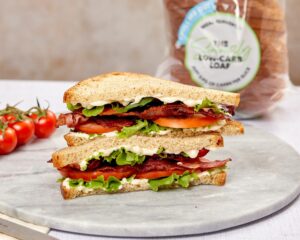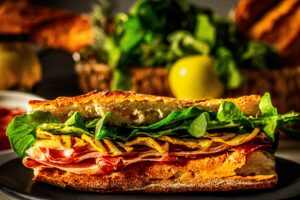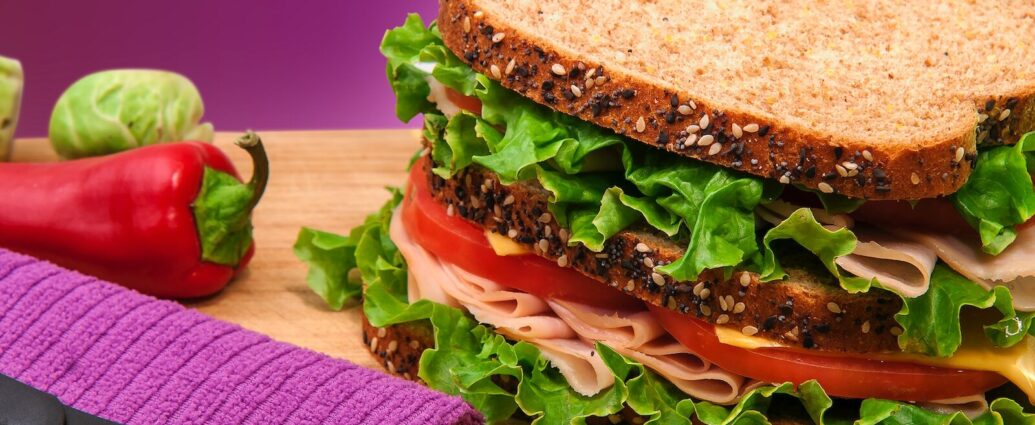Seven Standen
In the UK, we spend over £8,000,000,000 on sandwiches every year. Whether you prefer yours homemade, prepackaged, or made to order, there’s no doubt they’re one of the nation’s most popular foods. But the humble sandwich is something we frequently take for granted.
Sandwiches have transformed over time: from a snack enjoyed by the richest men in society to one of the cheapest meals you can make.
Regardless of the world changing rapidly around them, sandwiches have never gone out of fashion, largely due to their convenience. Where we buy them, how they’re prepared, and what they consist of may have changed, but the sandwich remains a British food staple.

The Invention of the Sandwich
A common misconception revolves around the idea that the 4th Earl of Sandwich, John Montagu, invented the sandwich.
His valet would often bring him salt beef between two pieces of toasted bread to eat while gambling at public houses. Montagu enjoyed sandwiches because they could be eaten one-handed, without cutlery. Unlike other foods, the bread meant sandwiches didn’t make his hands and cards greasy. These two factors made it a popular late-night meal amongst 18th-century aristocrats.
While the sandwich was named after and popularised by the Earl, it had already been enjoyed for centuries. Thick slabs of bread, usually coarse and stale, had been used as plates for food in the Middle Ages. Historians suggest these ‘trenchers’, eaten by the lower classes, were an earlier rendition of the sandwich.
“The British sandwich as we know it today wasn’t popularised in England until the Victorian era”
Further north, in Amsterdam, thin slices of beef were enjoyed on top of bread and butter in an open-face sandwich. Still eaten today, the belegde broodje was a predecessor of the sandwich — but wasn’t known in England at the time.
However, the ‘invention’ of the sandwich is a Eurocentric idea. Flatbreads have been used to wrap around small amounts of food, either for transportation or convenience, for centuries. Certainly, people were doing so in Asia and Africa long before John Montagu demanded his valet bring him a snack. It’s likely Montagu was inspired to eat meat wrapped in bread after consuming stuffed pitta bread while travelling in the Eastern Mediterranean.
The British sandwich as we know it today certainly wasn’t popularised in England until the Victorian era. But, far from inventing his namesake dish, Montagu had only switched flatbreads for sliced loaves.
The Best Thing Since Sliced Bread
During the 19th century, the sandwich boomed in popularity as the working classes had less time to prepare and eat food. Fast, portable, and inexpensive meals became essential in industrial society; a trend which we can trace directly to the lunches we eat today, usually in the workplace. By the 1850s, over 430,000 ham sandwiches were being sold on the streets of London each year.
Although a notable facet of sandwiches is the variety of fillings, red meat was the only option at the time. The first instance of cheese and egg sandwiches weren’t documented until the late 1800s and early 1900s respectively.
Still, they weren’t — and aren’t — as popular as ham. As recently as 2023, processed meat continues to dominate the sandwich industry, making up 38 per cent of those sold.

One innovation which made it possible to mass-produce sandwiches was the invention of sliced bread. This revolutionised the sandwich industry, boosting its popularity in the United States.
Despite being invented in the 1920s, the first slicing machine wasn’t introduced to the UK until 1937. But the change was immediately transformative. A little over 20 years later, 80 per cent of bread sold in Britain was pre-sliced.
Roadside Dining Revolution
In addition to being a popular street food, sandwiches were soon sold in cafes, railway stations, and pubs across the UK.
The development of public transport, such as the first railway opening in the 1830s, increased the popularity of travel and granted more mobility, making it more common to buy food on the go.
Prior to the invention of the motorway, the roadside cafe was the mainstay of British lorry drivers who travelled the major trunk roads. Located beside main roads, such as the A1 and A6, these cafes existed to feed motorists and often served sandwiches, later evolving into the modern service station.
“You couldn’t buy a British Rail sandwich without wondering if this was your last act before a long period on a life-support machine”
These service stations became a popular place for middle-class British families to visit for a meal out in the 1960s. Here, pub grub was enjoyed in addition to sandwiches. However, such fancy amenities were deemed unprofitable, so the quality of service stations was reduced dramatically.
Although there are fewer cafes and pubs alongside the motorways, service stations are still a common place to stop and buy a sandwich when travelling.
British Rail Sandwiches
The nationalisation of the railways in the 1940s led to the creation of the iconic British Rail sandwiches. These were sold for consumption on passenger trains and had a poor reputation for being either cold and soggy, or hard and stale.
Historian Keith Lovegrove writes: “The corners of the isosceles triangle-shaped bread would often curl up like the pages of a well-thumbed paperback.” The curling corners were due to the sandwiches being stored under glass domes on the counters in refreshment rooms all day.
British Rail sandwiches became symbolic of the poor quality of food available for travellers and commuters. Despite being the butt of the joke in popular British culture, at least eight million sandwiches were sold a year on British Rail — there was no other option for hungry passengers.
Mmmmm. “The journey fillers”.
Delicious British Rail sandwich poster from 1981, shortly after #GBBO’s Prue Leith joined the organisation’s board in 1980. pic.twitter.com/Wg5tPVODvU— Tim Dunn (@MrTimDunn) October 2, 2018
In Notes from a Small Island (1995), Bill Bryson famously wrote: “You couldn’t buy a British Rail sandwich without wondering if this was your last act before a long period on a life-support machine.”
Great British Bake Off judge Prue Leith played a central role in improving the catering on British railways. Innovative new fillings, like prawn and egg (not together!), were initially compared to the sales of the old British Rail sandwich. The new sandwiches, which stayed fresh and delicious, were a great success.
The Great British Meal Deal
A staple of British culture today, the pre-packaged sandwich you grab from the supermarket shelf was pioneered by Marks and Spencer in the 1980s. Originally, the store repackaged sandwiches they had failed to sell in their adjoining cafe and put them out in the food aisles.
Salmon and tomato was the original recipe, but egg and cress, as well as pilchard, soon joined it on the shelves. Although the idea seemed ridiculous at the time, the experiment was so successful that M&S introduced it at other stores.
“A whole new way of eating lunch was born”
Soon enough, a seven-person team making sandwiches in-store wasn’t sufficient to keep up with the demand. M&S approached suppliers to industrialise the process, creating the first sandwich-making factories in the UK. Following the smell of money, other supermarkets began to produce their own pre-packaged sandwiches and a whole new way of eating lunch was born.
But any expert in British cuisine knows the pre-packaged sandwich is nothing without the accompanying snack and drink. Pharmacy Boots, which had jumped on the trend, was the first store to introduce the concept of the “meal deal.” Prized for convenience and value for money, more than a third of Britons today buy a meal deal at least once per week!
Interestingly, the majority of us choose the same meal every time. This phenomenon is due to several factors: distraction, diversification bias, and decision fatigue.
My first Tesco meal deal. Sandwich and crisps are good! pic.twitter.com/DM42swydss
— Alex Smith (@MathNerdAlex) September 6, 2023
Have It Your Way!
Naturally, the response to the industrialisation and mechanisation of the sandwich-making process was a demand for the opposite. While people praised the convenience of pre-packaged sandwiches, the alarming rise of technology led to us demanding homemade food instead.
Independent sandwich shops first emerged during the 1980s, making customised sandwiches to order in front of their customers.
One of the earliest chains to establish itself was Philpotts. Founded in 1985, it quickly became “the most respected sandwich company in the country”. These shops offered all the convenience of a pre-packaged sandwich but with the freshness and customisability of a homemade sandwich.
“Sandwich shops became a healthier alternative to burgers and chips.”
Fast food already existed in the UK, with the iconic Wimpy Burger having been established in 1954. But American chains had begun to infiltrate the country. The first McDonalds and Burger King were opened in 1974 and 1976 respectively. By the 1980s, they were popular among British customers and fast food chains were more normalised than in the decade earlier. The need for speed established among consumers meant sandwich shops became a healthier alternative to burgers and chips.

As the popularity of sandwich stores increased, the number of chains and franchises competing to be number one rose.
Subway, which had already spread across the US, opened its first UK store in 1996. Bakery Greggs started to sell sandwiches, in addition to their pastries and cakes, and found surprising success. In 2012, they were even named ‘Specialist Sandwich Chain of The Year’.
By the 21st century, the sandwich industry was worth billions of pounds per year.
The Decline of the Sandwich
In 2022, UK consumers spent over 512 million British pounds on sandwiches, rolls, and baguettes. However, the expansion of lunch options in the UK is a looming threat to the industry.
Recent numbers from Tesco show sushi is the UK’s fastest-growing premium lunchtime food. Since the start of 2023, sales have increased by 90 per cent and sushi has replaced the smoked salmon sandwich as the most popular premium lunch.
Many people have turned away from sandwiches as a regular lunch. An estimated 5.1 million people in Great Britain consume instant snacks and ready-to-eat salads on a regular basis. While sandwiches once reigned supreme, the variety of food now on offer means plenty of Britons enjoy sushi, salad, and snacks for lunch instead.

The trend towards ‘healthier eating’ could also be a factor in the decline of sandwich consumption. As many as 62 per cent of Britons have altered their diet to be ‘healthier’ in recent years. Up to 69 per cent of us now plan our meals in advance, making us less likely to ‘impulse buy’ a meal deal. Although sandwiches are a perfectly healthy choice, anxiety around carbs was perpetuated by the media during the obesity crisis. Low-carb diets, such as Keto, remain incredibly popular today.
A Whole New World of Sandwiches
Many sandwiches have evolved beyond recognition.
One invention popular among dieters is the ‘lettuce wrap’, which substitutes the bread of a sandwich for pieces of lettuce. Open sandwiches — like the trenchers in the Middle Ages — are also a common choice as they allow for more fillings.
On the other end of the scale, toast or crisp sandwiches reflect the growing poverty in Britain.
Due to globalisation, we also enjoy and fuse cuisines from around the world with our sandwiches. Ingredients like kimchi and falafel are now enjoyed alongside British ‘classics’. Users on TikTok and Instagram are able to tell the world about their favourite sandwiches. These are often inspired by their own backgrounds and cultures.

Nowhere is the melting pot of British culture seen more than in the popular coronation sandwich. Created in 1953, this sandwich fused Indian and English tastes to celebrate the coronation of Queen Elizabeth II.
While the traditional white-bread-and-ham British sandwich may have declined, we now have more diversity than ever: cheese toasties, burgers and hot dogs, and even pre-packaged Lunchables. The conventional sandwich may be making way for a greater variety of options.
READ NEXT:
-
WHAT IS THE FUTURE OF THE MEAT INDUSTRY?
-
A BRIEF HISTORY OF THE COLOUR PINK
-
WHAT I EAT IN A DAY: INSPIRING OR HARMFUL?
Featured image courtesy of Amanda Vick via Unsplash. No changes made to this image. Image license found here.

